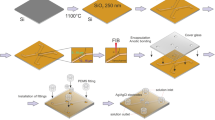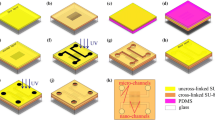Abstract
The forming process of U-form glass micro-nanofluidic chip with long nanochannels is presented in this paper, in which the fabrication of channels and the assembly of plates are included. The micro-nanofluidic chip is composed of two glass plates in which there are microchannels and nanochannels, respectively. This chip can be used for trace sample enrichment, molecule filtration, and sample separation, etc. In fabrication process, the two-step photolithograph on one wafer is often required in early papers, as nano and micro structure designed in one plate have different depths. In this paper, the channels in micro-nanofluidic chip are designed in two glass plates instead of in one wafer. The nanochannels and microchannels are, respectively, formed on plates using wet etching and two-step photolithograph on one wafer is not required. Since the channels are formed, the upper plate and the bottom plate are assembled together by alignment, preconnection and thermal bonding orderly. Firstly these plates are aligned with the cross-marks on an inverted microscope. The aqueous film between plates is controlled to decrease the static friction force for accurate adjustment. Then the adhesion strength of connection is enhanced with semi-dry status for limiting movement from slight inclining and shaking. At last, the bottom plate and the upper one are irreversibly linked together with thermal bonding. The heating period and max temperature of thermal bonding are optimized to eliminate thermal stress gradient and the size shrinking. With the micro-nanofluidic chip, the 1 μM fluorescein isothiocyanate in 10 mM PBS buffer is concentrated successfully. The sample concentrating factor of light intensity varies from 2.2 to 8.4 with applied voltages between 300 and 2,000 V. The switch effect and the instability effect in concentrating process are described and analyzed too.








Similar content being viewed by others
References
Anthony LG, Linnea KI, Dimiter NP et al (2005) Electrokinetic molecular separation in nanoscale fluidic channels. Lab Chip 5:1271–1276
Datta A, Gangopadhyay S, Temkin H (2006) Nanofluidic channels by anodic bonding of amorphous silicon to glass to study ion-accumulation and ion-depletion effect. Talanta 68:659–665
Huang KD, Yang RJ (2008) Formation of ionic depletion/enrichment zones in a hybrid micro-/nano-channel. Microfluid Nanofluid 5:631–638
Kim SM, Mark AB, Ernest FH (2006) Electrokinetic protein preconcentration using a simple glass/poly microfluidic chip. Anal Chem 14:4779–4785
Kim SJ, Wang YC, Lee JH, Jang H et al (2007) Concentration polarization and nonlinear electrokinetic flow near a nanofluidic channel. Phys Rev Lett 7:1–4
Mao P (2005) Fabrication and characterization of nanofluidic channels for studying molecular dynamics in confined environments. Ph.D. Thesis, Massachusetts Institute of Technology
Patrick A, Low LN, Nguyen NT (2006) Fabrication of planar nanofluidic channels in a thermoplastic by hot-embossing and thermal bonding. Lab Chip 7:520–522
Plecis A, Schoch RB, Renaud P (2005) Ionic transport phenomena in nanofluidics: experimental and theoretical study of the exclusion-enrichment effect on a chip. Nano Lett 5:1147–1155
Probstein RF (1994) Physicochemical hydrodynamics: an introduction, 2nd edn. Wiley, New York
Pu Q, Yun J, Temkin H, Liu S (2004) Ion-enrichment and ion-depletion effect of nanochannel structures. Nano Lett 4:1099–1103
Schoch RB (2006) Transport phenomena in nanofluidics: from ionic studies to proteomic applications. Ph.D. Thesis No. 3538, EPFL, Lausanne
Schoch RB, Bertsch A, Renaud P (2006) pH-controlled diffusion of proteins with different pI values across a nanochannel on a chip. Nano Lett 6:543–547
Thomas SH, Nicolas FdR et al (2006) Fabrication and electroosmotic flow measurements in micro- and nanofluidic channels. Microfluid Nanofluid 2:117–124
Wang YC, Stevens AL, Han J (2005) Million-fold preconcentration of proteins and peptides by nanofluidic filter. Anal Chem 77:4293–4299
Acknowledgments
This project is supported by the National High Technology Research and Development Program of China (863 Program, No: 2007AA04Z302), Major State Basic Research Development Program of China (No: 2007CB714502), and National Natural Science Foundation of China (No: 50705012, No: 20890024, No: 50605006).
Author information
Authors and Affiliations
Corresponding author
Rights and permissions
About this article
Cite this article
Xu, Z., Wen, Jk., Liu, C. et al. Research on forming and application of U-form glass micro-nanofluidic chip with long nanochannels. Microfluid Nanofluid 7, 423–429 (2009). https://doi.org/10.1007/s10404-009-0407-8
Received:
Accepted:
Published:
Issue Date:
DOI: https://doi.org/10.1007/s10404-009-0407-8




